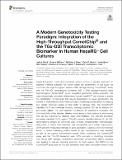A Modern Genotoxicity Testing Paradigm: Integration of the High-Throughput CometChip® and the TGx-DDI Transcriptomic Biomarker in Human HepaRG™ Cell Cultures
Author(s)
Buick, Julie K; Williams, Andrew; Meier, Matthew J; Swartz, Carol D; Recio, Leslie; Gagné, Rémi; Ferguson, Stephen S; Engelward, Bevin P; Yauk, Carole L; ... Show more Show less
DownloadPublished version (4.285Mb)
Publisher with Creative Commons License
Publisher with Creative Commons License
Creative Commons Attribution
Terms of use
Metadata
Show full item recordAbstract
<jats:p>Higher-throughput, mode-of-action-based assays provide a valuable approach to expedite chemical evaluation for human health risk assessment. In this study, we combined the high-throughput alkaline DNA damage-sensing CometChip<jats:sup>®</jats:sup> assay with the TGx-DDI transcriptomic biomarker (DDI = DNA damage-inducing) using high-throughput TempO-Seq<jats:sup>®</jats:sup>, as an integrated genotoxicity testing approach. We used metabolically competent differentiated human HepaRG™ cell cultures to enable the identification of chemicals that require bioactivation to cause genotoxicity. We studied 12 chemicals (nine DDI, three non-DDI) in increasing concentrations to measure and classify chemicals based on their ability to damage DNA. The CometChip<jats:sup>®</jats:sup> classified 10/12 test chemicals correctly, missing a positive DDI call for aflatoxin B1 and propyl gallate. The poor detection of aflatoxin B1 adducts is consistent with the insensitivity of the standard alkaline comet assay to bulky lesions (a shortcoming that can be overcome by trapping repair intermediates). The TGx-DDI biomarker accurately classified 10/12 agents. TGx-DDI correctly identified aflatoxin B1 as DDI, demonstrating efficacy for combined used of these complementary methodologies. Zidovudine, a known DDI chemical, was misclassified as it inhibits transcription, which prevents measurable changes in gene expression. Eugenol, a non-DDI chemical known to render misleading positive results at high concentrations, was classified as DDI at the highest concentration tested. When combined, the CometChip<jats:sup>®</jats:sup> assay and the TGx-DDI biomarker were 100% accurate in identifying chemicals that induce DNA damage. Quantitative benchmark concentration (BMC) modeling was applied to evaluate chemical potencies for both assays. The BMCs for the CometChip<jats:sup>®</jats:sup> assay and the TGx-DDI biomarker were highly concordant (within 4-fold) and resulted in identical potency rankings. These results demonstrate that these two assays can be integrated for efficient identification and potency ranking of DNA damaging agents in HepaRG™ cell cultures.</jats:p>
Date issued
2021Department
Massachusetts Institute of Technology. Department of Biological EngineeringJournal
Frontiers in Public Health
Publisher
Frontiers Media SA
Citation
Buick, Julie K, Williams, Andrew, Meier, Matthew J, Swartz, Carol D, Recio, Leslie et al. 2021. "A Modern Genotoxicity Testing Paradigm: Integration of the High-Throughput CometChip® and the TGx-DDI Transcriptomic Biomarker in Human HepaRG™ Cell Cultures." Frontiers in Public Health, 9.
Version: Final published version